Physical Address
304 North Cardinal St.
Dorchester Center, MA 02124
![]() Access video content for this chapter online at Elsevier eBooks+
Access video content for this chapter online at Elsevier eBooks+
Acquired cranio-orbital deformities comprise a vast array of etiological entities which result in defects, disproportions, or asymmetries in the upper face and skull, and they are commonly associated with functional visual and neurological disturbances. Reconstruction poses a unique set of challenges. Restoration of the complex surface topography and structural integrity of the skull and orbits, while maintaining visual, oculomotor, and neurological functions, is the primary objective.
Although the principles of cranio-orbital reconstruction were established in the mid 20th century, recent advances in medical imaging, computer modeling, and rapid prototyping technologies have revolutionized how we assess and confront these surgical challenges. The advent of 3D imaging and quantitative analysis of morphology, intra-operative navigation techniques, 3D modeling, and rapid prototyping of patient-specific implants, templates, and surgical guides has greatly enhanced preoperative surgical planning and optimized outcomes.
This chapter briefly summarizes the surgically relevant anatomy of the cranium and orbit, describes preoperative clinical and radiological assessment, discusses direct applications of computer imaging, modeling, and rapid prototyping, and presents treatment algorithms for both cranial and orbital reconstruction.
Normal skull shape varies with age, sex, and ethnic origin. Adult normocephaly is characterized by an “egg” shape when viewed from above, slightly wider posteriorly and narrower anteriorly. The forehead is defined by two regions. Inferiorly, the supraorbital bar, comprising the glabella and supraorbital rims, is relatively flat transversely and angular at the lateral orbital rims. The specific shape is highly variable and determined by sex and size of the underlying frontal sinuses. The upper forehead features slight vertical and transverse convexity, and it is limited laterally by the temporal ridges. The temporal bones are relatively flat and monocortical. The parietal bones are convex transversely and bicortical.
The orbital cavities are paired, symmetrical cavities located between the skull and midface. Each orbit features a pyramidal shape, starting as a four-sided pyramid along the orbital rims and tapering into a three-sided pyramid towards the apex ( Fig. 5.1 ) where the floor and medial wall merge. The longitudinal axis of each pyramid is oblique, oriented in an inferolateral to superomedial direction from base to apex.
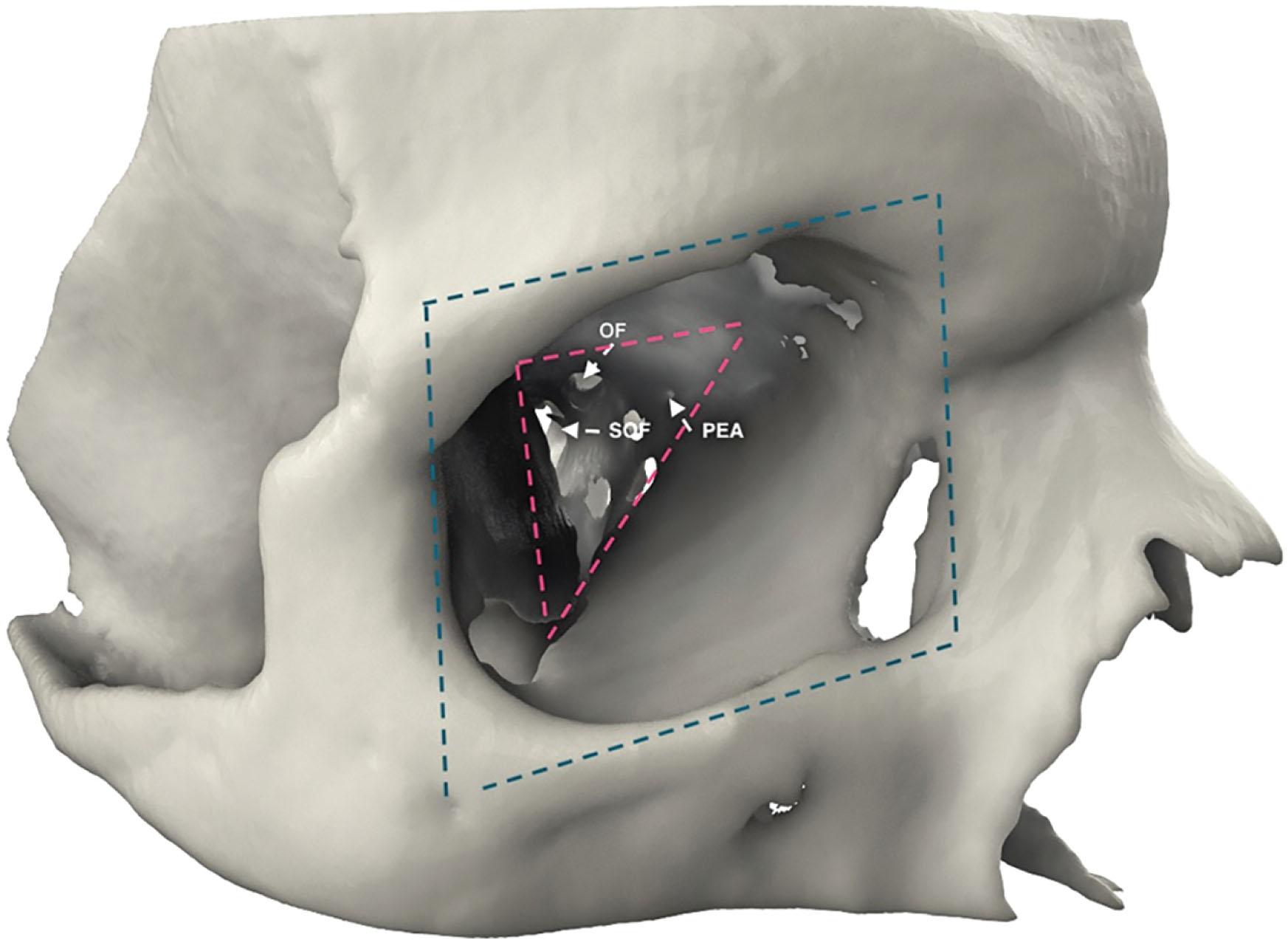
The bony orbit is subdivided into two main components for surgical considerations ( Fig. 5.2 ):
The deep orbital cavity or orbital apex is the fixed segment of the orbital cavity, which accommodates the critical structures passing through the optic foramen and superior orbital fissure.
The circumferential bony rim of the orbit is composed of thick resilient bone which defines the shape and dimensions of the orbital aperture. This is the movable orbit, which can be safely transposed in any direction, in one or multiple segments. Precise anatomical restoration is a prerequisite for accurate restoration of globe position, as well as palpebral fissure width and inclination.
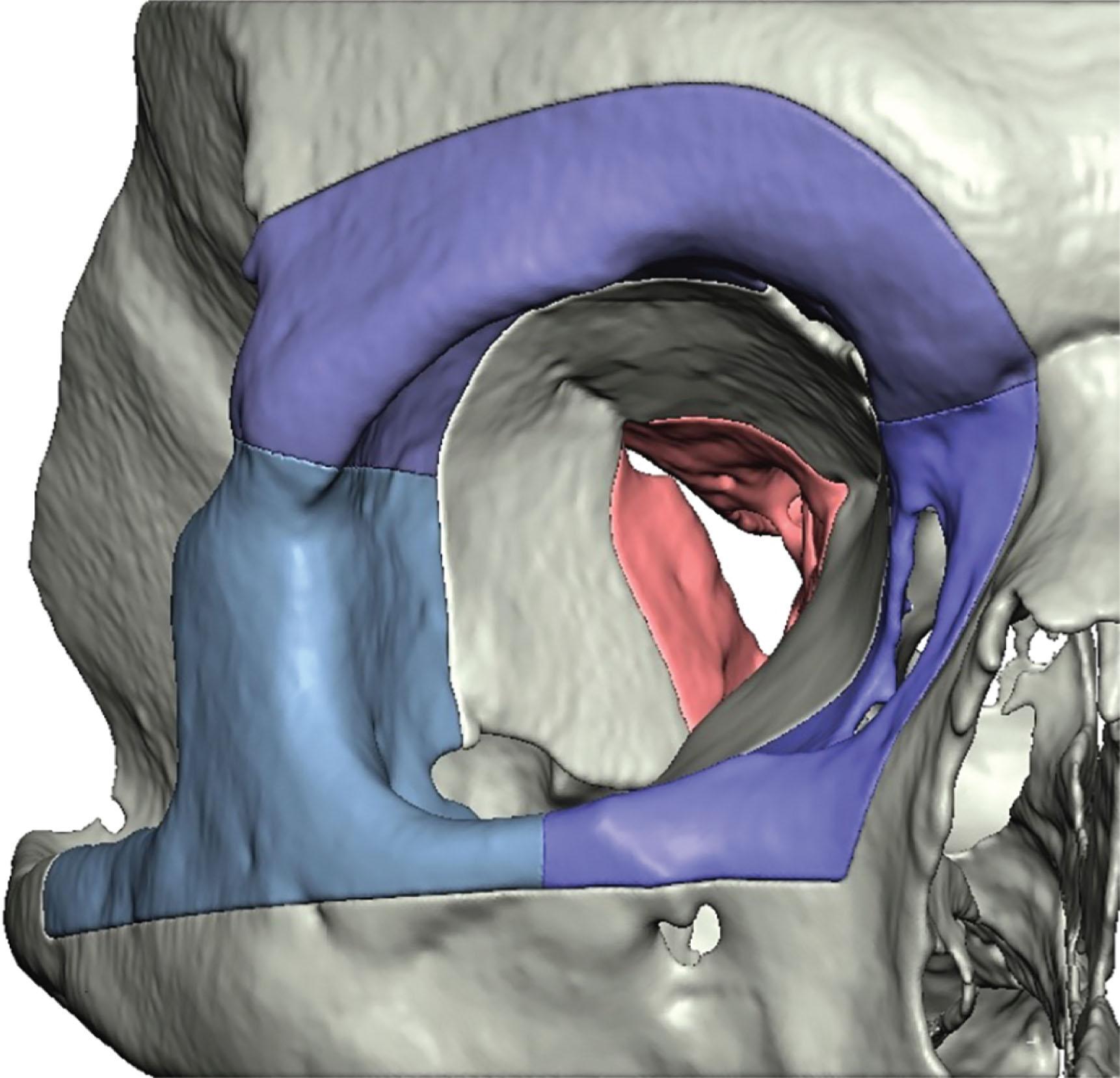
The inferior orbital fissure defines the lateral boundary of the orbital floor and encases CN V2, the infraorbital artery, and sympathetic rami from the pterygopalatine ganglion. The superior orbital fissure is located near the apex of the orbit and it accommodates critical structures as they enter the orbit from the cranial fossa (CN III, IV, V1, and the superior ophthalmic vein). At the orbital apex, just medial to the superior orbital fissure, lies the optical canal through which the optic nerve and ophthalmic artery run.
Current principles of cranio-orbital reconstruction are based primarily on the teachings of Dr. Paul Louis Tessier (1917–2008). In the mid 1950s, while at Hôpital Foch in Paris with Gerard Guiot and in London alongside Sir Harold Gillies, Dr. Tessier pioneered craniofacial surgery. The novel surgical approaches and techniques which he developed allowed reconstruction of complex congenital craniofacial malformations with unprecedented safety and efficacy. These principles were readily adopted in the reconstruction of acquired cranio-orbital deformity. The following fundamental guidelines established by Dr. Tessier are still highly relevant today:
Segments of the bony facial skeleton can be entirely stripped of periosteum, osteotomized, and transposed to a new anatomical location, with the expectation of consolidation and shape preservation. Furthermore, autogenous bone grafts placed within residual bony gaps lead to more stable long-term outcomes.
The orbital soft-tissue contents can be freely mobilized within a periorbital cone pedicled on the orbital apex and superior orbital fissure, without adversely affecting ocular, oculomotor, palpebral, or lacrimal function. As such, the orbits and eyes can be safely translocated vertically or horizontally, as needed, over a considerable distance.
Combined intracranial and extracranial exposure allows safe retraction of both cranial and orbital contents for direct visualization of deeper or more critical structures in the fronto-orbital or nasoethmoid regions.
Adherence to these principles ensures optimal protection of critical structures while manipulating facial skeletal segments to meet the specific reconstructive requirements in any patient.
The septum orbitale defines the anterior aspect of the orbit, separating the lid contents from the orbital contents. Deep to the septum lies the orbital fat, made up of both intraconal and extraconal fat depending on its position in relation to the extraocular muscles. The extraconal fat compartment is located mainly in the anterior orbit, whereas the intraconal fat primarily occupies the posterior orbit.
Subperiosteal dissection within the orbital cavity allows circumferential mobilization of the orbital soft-tissue contents. While dissection of contents from the inferior orbital fissure can be done safely, the posterior attachments at the orbital apex and superior orbital fissure must be maintained. Orbital soft tissues can be entirely contained within a periorbital–periosteal cone that is pedicled on the orbital apex and superior orbital fissure, thus preserving ocular, oculomotor, palpebral, and lacrimal functions.
An understanding of the normal spatial relationship between the ocular globe and orbital cavity is fundamental to the planning of orbital reconstruction. Pearl first described the axis of the globe, which traverses the orbit from the lateral orbital rim to the posterior lacrimal crest and bisects the globe into anterior and posterior halves ( Fig. 5.3 ). Displacements of the orbit posterior to the axis of the globe primarily affect ocular projection in the anterior/posterior plane (enophthalmos or proptosis), while displacements anterior to the axis affect ocular position in the superior/inferior plane (hypoglobus or hyperglobus).
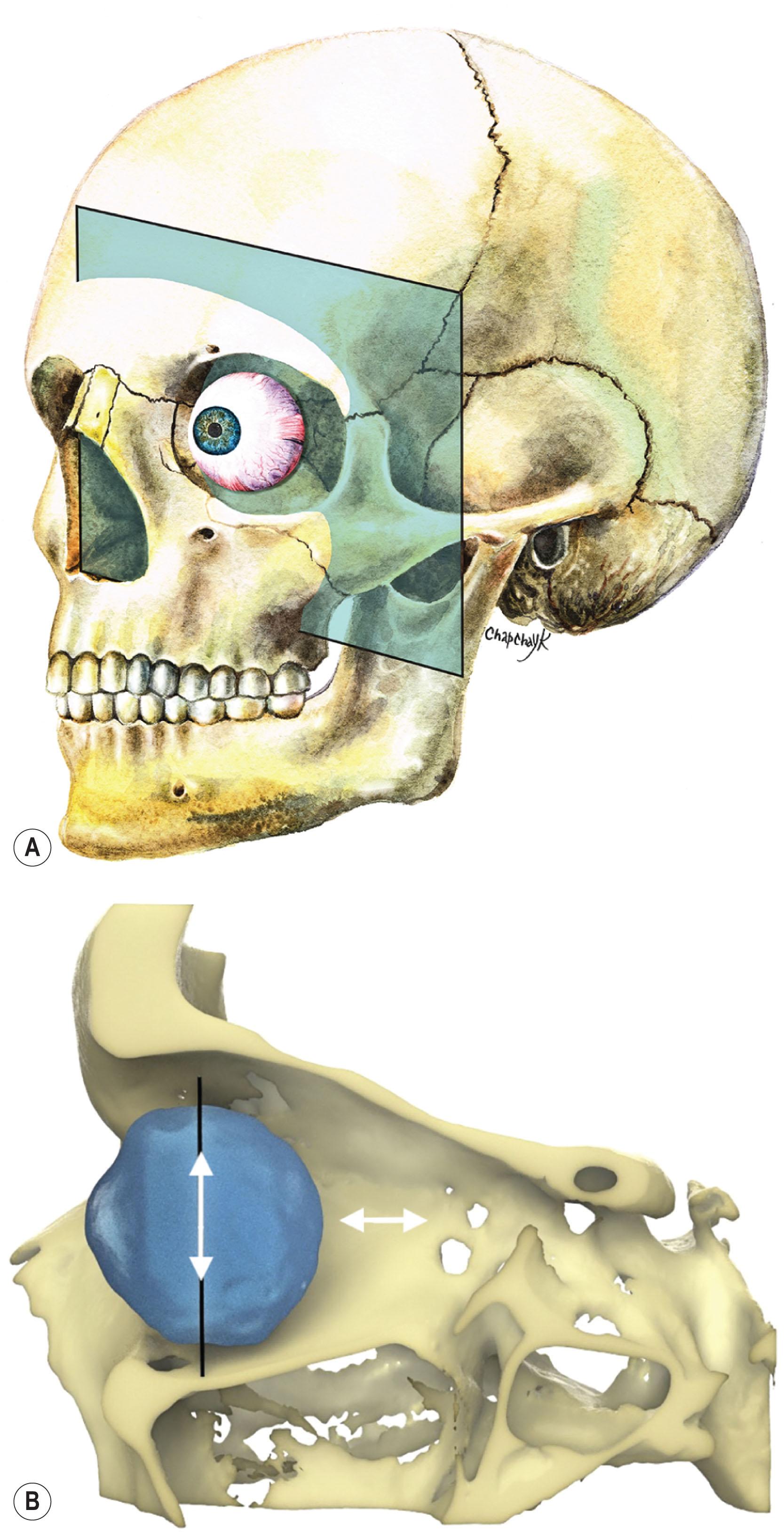
Acquired cranial deformities are best classified etiologically ( Box 5.1 ). The vast majority of deformities feature “known” or established full-thickness skull defects, such as those resulting from prior trauma, craniectomy, or craniotomy with failed bone flap replacement ( Fig. 5.4 ). Less common are “unknown” or intra-operative defects of the cranium, such as those resulting from surgical excision or ablation of pathological lesions. For these “unknown” defects, the size and shape of the skull defect cannot yet be predicted, as the precise dimensions are determined intra-operatively during lesion resection.
Post craniectomy
Post craniotomy
Post traumatic
Osteitis
Osteomyelitis
Sinus related (sinusitis/abscess/mucocele)
Acromegaly
Fibrous dysplasia
Paget's disease
Osteosclerosis
Benign
Bone forming
Osteoma
Ossifying fibroma
Osteoblastoma
Cartilage forming
Chondroma
Chondromyxoid fibroma
Chondroblastoma
Tumors of connective tissue
Desmoplastic fibroma
Histiocytic tumors
Giant cell granuloma
Non-ossifying fibroma
Cysts
Epidermoid
Dermoid
Aneurysmal bone cyst
Vascular
Eosinophilic granuloma
Intraosseous hemangioma
Meningioma
Malignant, primary
Bone forming
Osteosarcoma
Malignant myeloma
Cartilage forming
Chondrosarcoma
Tumors of connective tissue
Fibrosarcoma
Histiocytic tumors
Ewing's sarcoma
Giant cell (osteoclastoma)
Vascular
Angiosarcoma
Meningioma
Malignant, secondary
Metastatic
Contiguous spread
Squamous cell carcinoma
Basal cell carcinoma
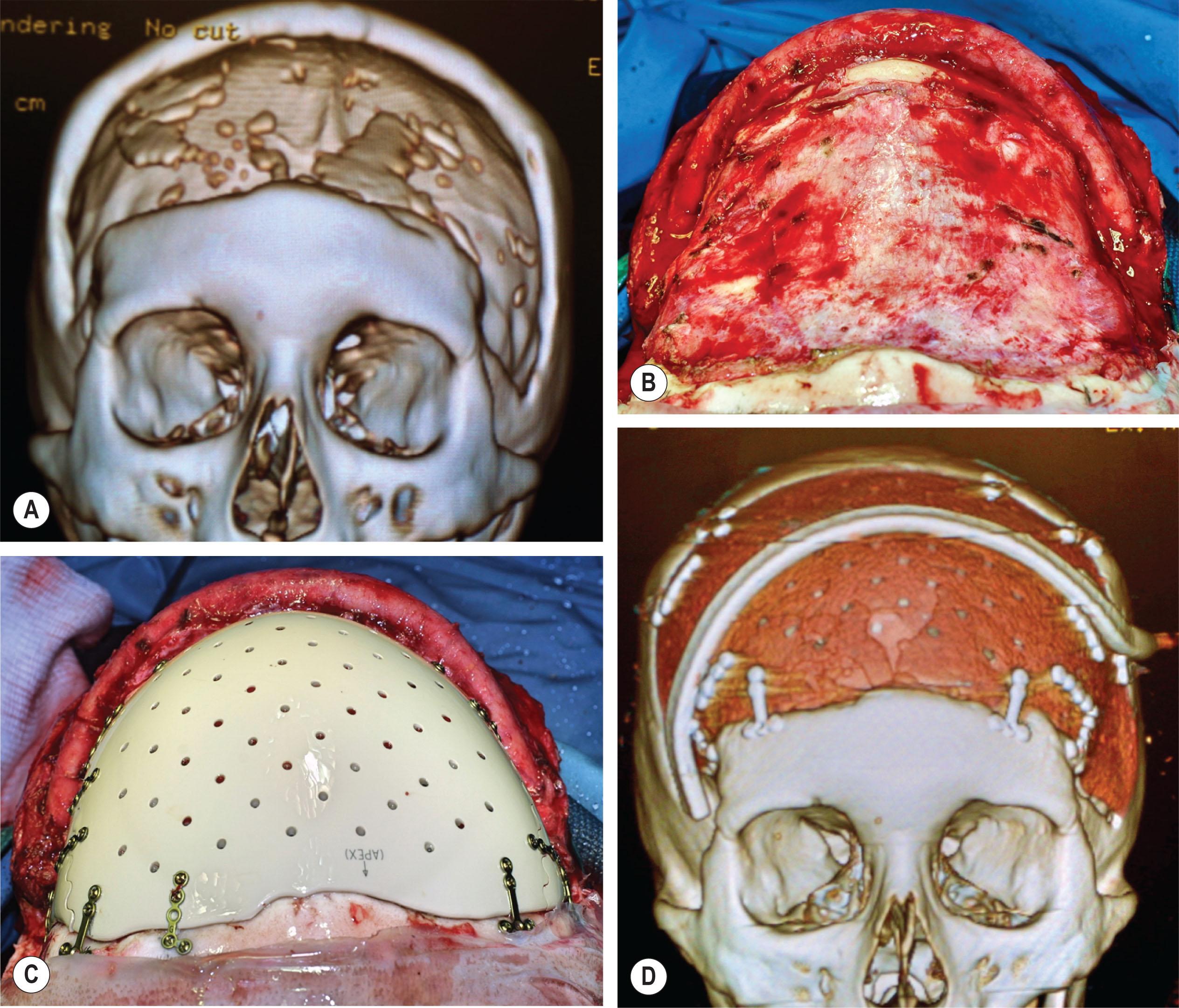
Cranial infections include those resulting from infected mucocele ( Fig. 5.5 ) or sinusitis, infected hardware or cranioplasty implant, and from osteomyelitis. In these clinical settings, source identification and proper antibiotic treatment are sought out prior to any reconstructive planning.
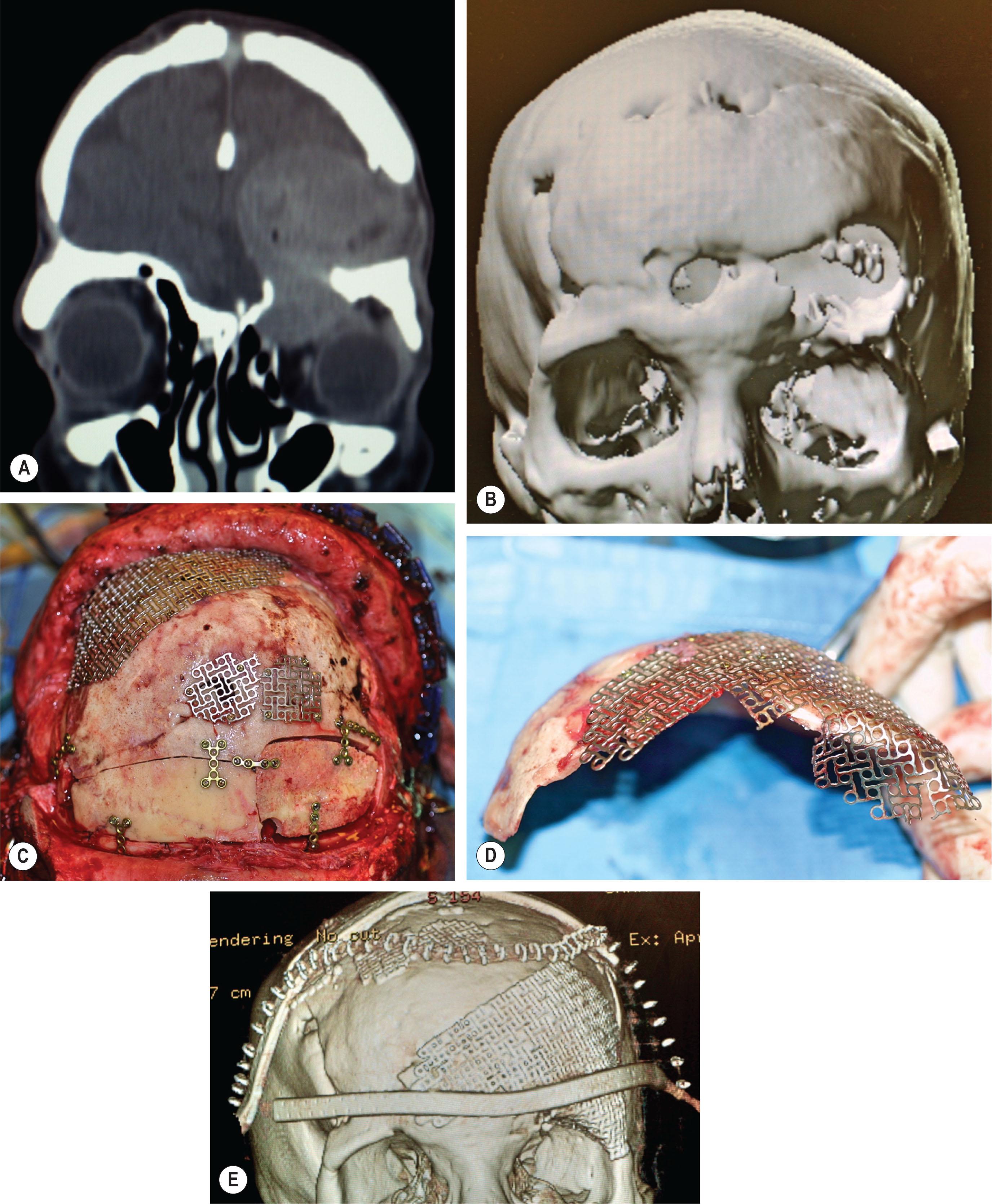
Generalized calvarial hypertrophy, sclerosis, atrophy, or rarefaction require specific investigations to rule out any underlying metabolic or endocrinologic disorders. While complete cure of the bony disease is unlikely, reconstruction of deformities resulting from debulking procedures is aimed at improving normal surface contour.
Bone tumors of the cranial vault, both benign and malignant, can present as primary lesions ( Figs. 5.6 & 5.7 ) or appear following contiguous or metastatic spread ( Fig. 5.8 ). These neoplastic lesions can arise from varying tissue cell origins, such as bone, cartilage, skin, connective tissue, salivary glands, vasculature, or any combination of these. Furthermore, skin tumors of the scalp, such as basal cell and squamous cell carcinomas, can exhibit aggressive and rapid growth, infiltrating underlying bone. Before commencement of bony reconstruction, resection of involved soft and bony tissue needs to extend to healthy surgical margins.
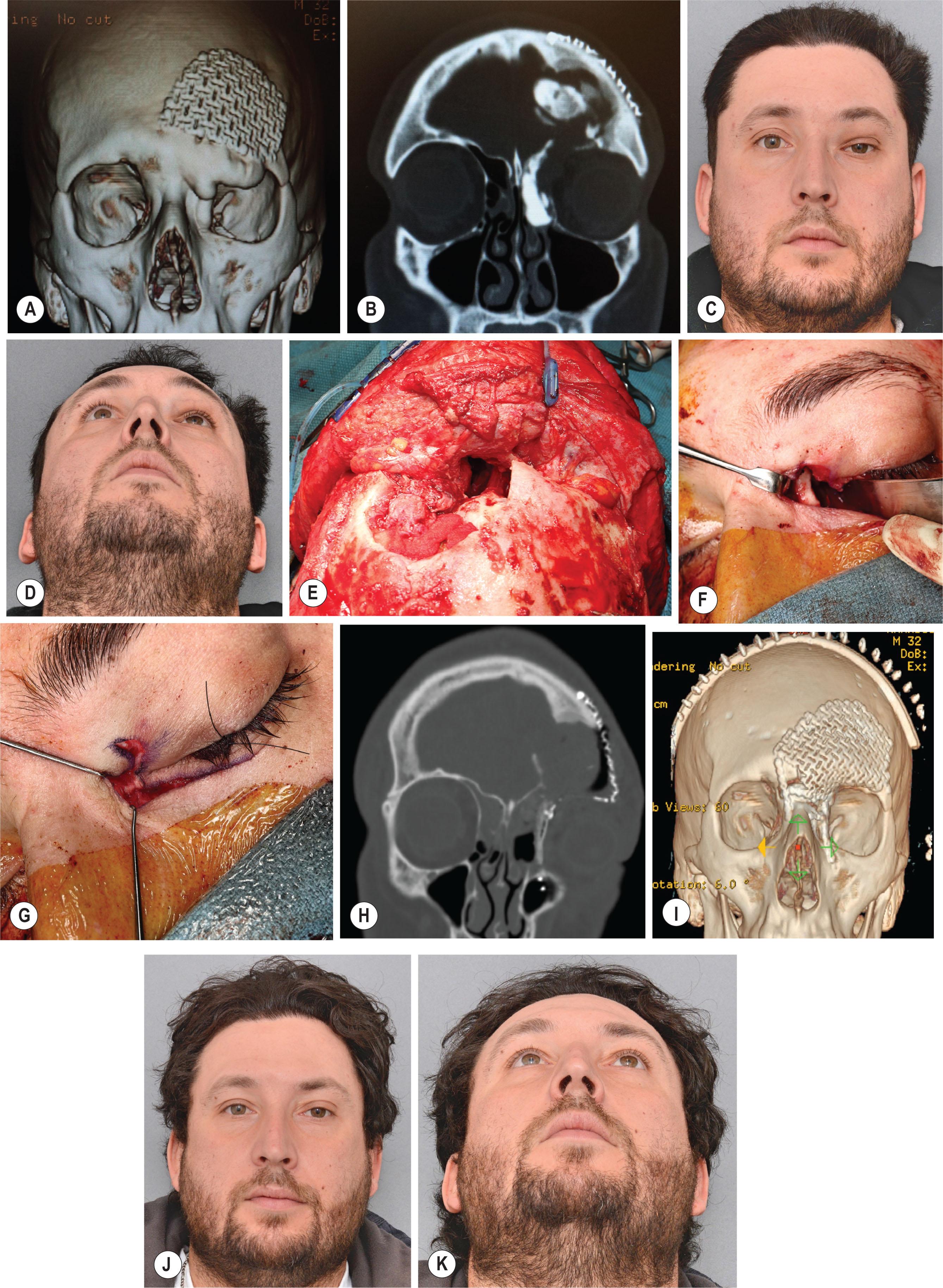
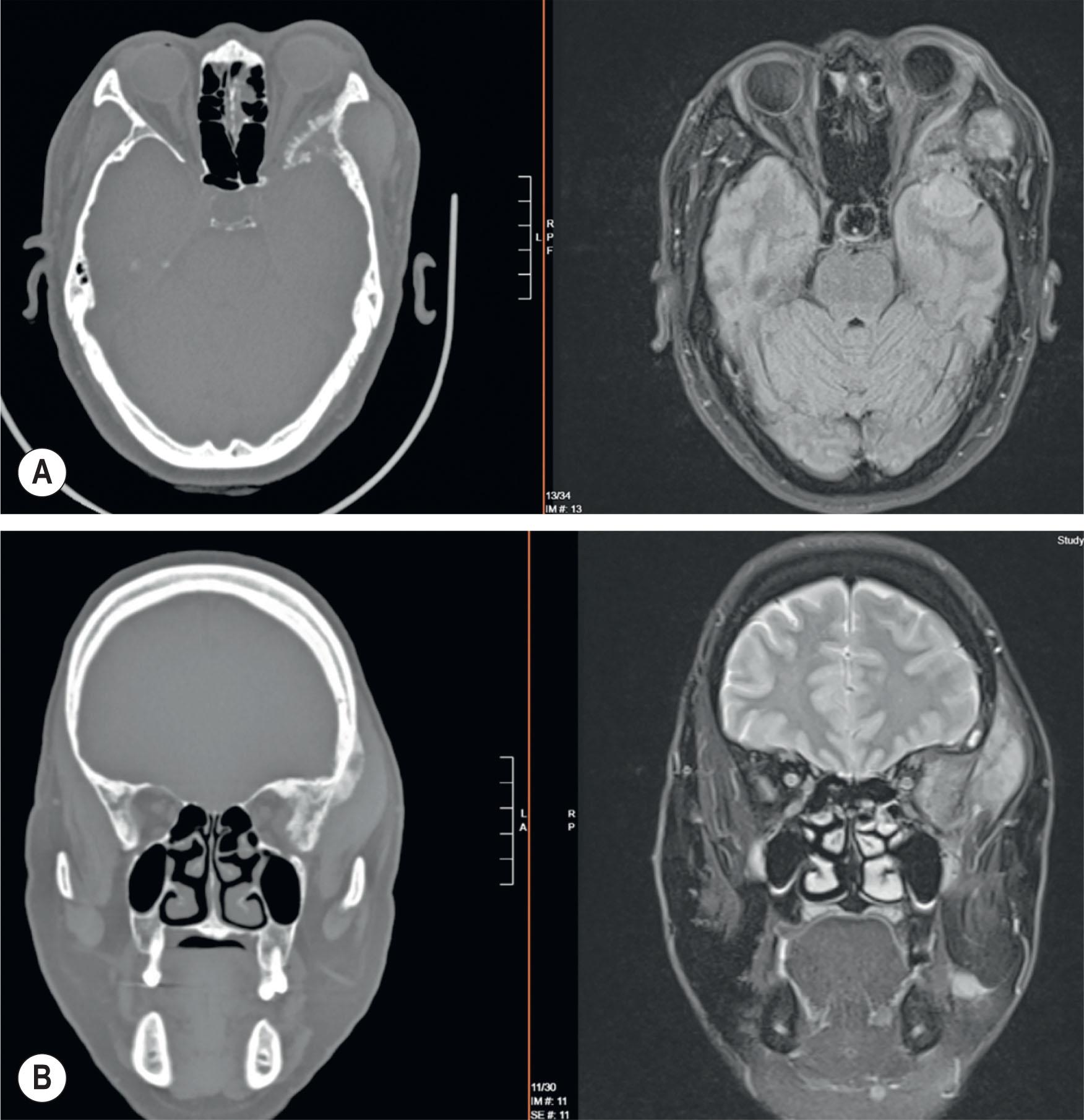
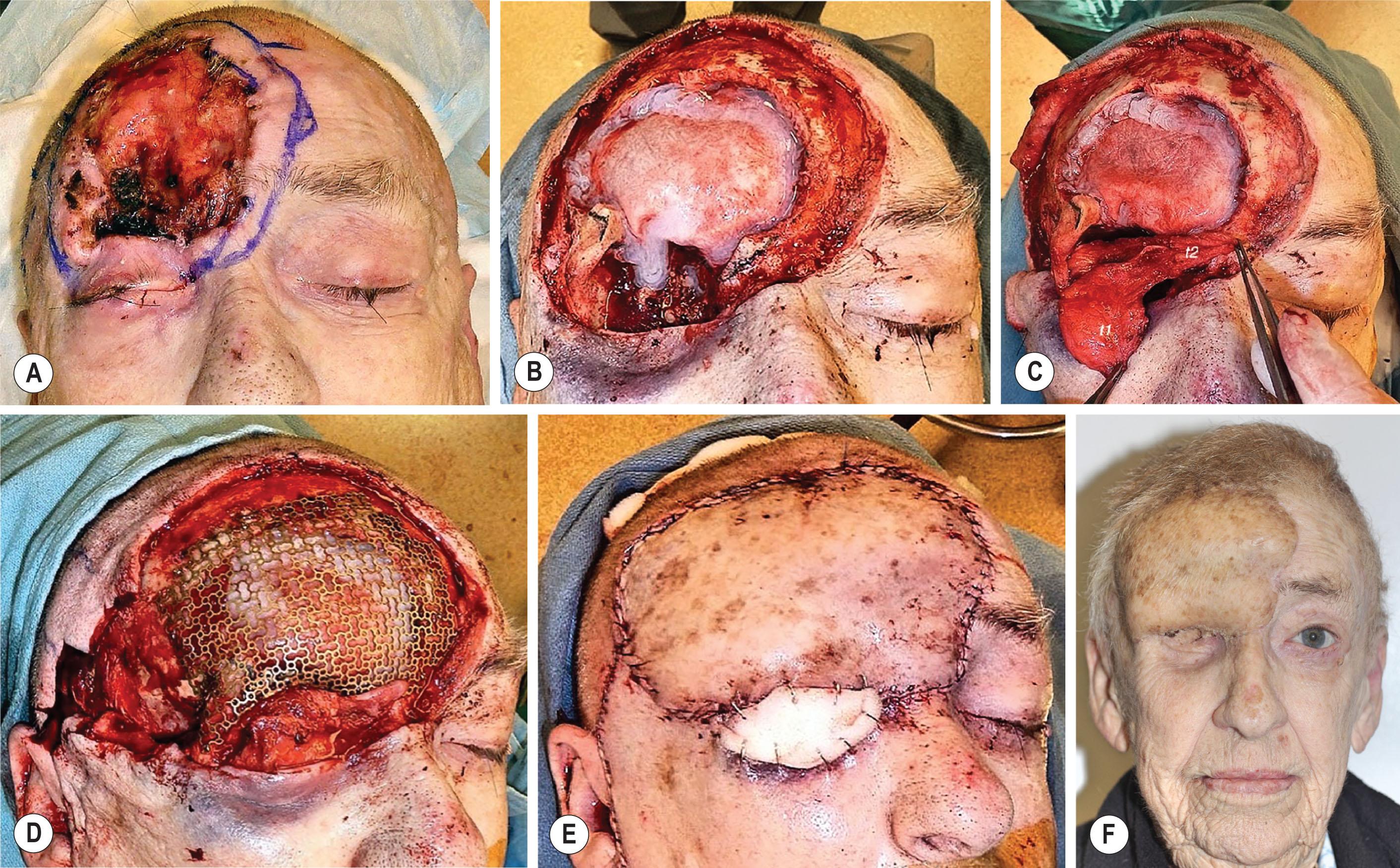
Acquired orbital deformities are classified according to the oculo/orbital malposition or defect ( Box 5.2 ). This classification serves to direct treatment options, while guiding relevant surgical investigations and planning.
Proptosis
Increase in intra-orbital soft-tissue volume
Decrease in orbital cavity volume
Enophthalmos
Decrease in intra-orbital soft-tissue volume
Increase in orbital cavity volume
Become a Clinical Tree membership for Full access and enjoy Unlimited articles
If you are a member. Log in here